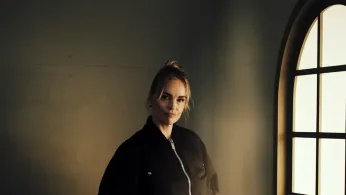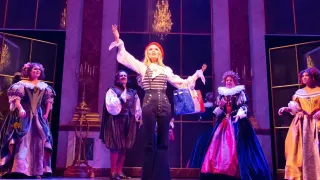
4 hours ago
Nina Hoss, Queer Icons, and the Sapphic Revolution of"Hedda"
READ TIME: 4 MIN.
When Nina Hoss enters a room, as herself or as Eileen Lövborg in Nia DaCosta’s adaptation of “Hedda,” the atmosphere shifts—suddenly, anything seems possible. She brings that same electric presence to the screen, where her portrayal of Eileen not only breaks new ground as the first female incarnation of Ibsen’s infamous Lovborg, but does so as an unapologetically queer woman. Against the backdrop of 1950s England, Hoss, alongside Tessa Thompson’s Hedda and Imogen Poots’ Thea, crafts a world brimming with queer longing, intellectual fire, and the kind of fierce, complicated love that still feels radical on mainstream screens .
The word “icon” gets tossed around a lot in queer circles, but when Nina Hoss is asked if she knows she’s a gay icon, she beams: “I feel so good about that. I love hearing that” . And why not? Hoss’s career—spanning from cult classics to prestige dramas—has long resonated with LGBTQ+ audiences, but “Hedda” represents something bigger: a full-bodied, visible, and complex queer woman who commands space rather than shrinking from it.
DaCosta’s adaptation isn’t just a gender swap; it’s a re-centering. By transforming Eilert Lövborg into Eileen, the film infuses Ibsen’s classic with fresh urgency. “By making an Eileen out of Eilert, to me, it felt so liberating, since it’s never been done—there’s no comparison. There has never been a female Lövborg, so for all of us—Tessa as Hedda and Imogen as Thea—we’re queer. What kind of tension does that heighten, or how does it make the conflict and drama even deeper? It unlocked something that I had never thought about before” .
The love triangle at the heart of “Hedda” is not subtext—it’s front and center. In conversation with Gay Times, Hoss and Poots discuss the power of seeing three queer women—each wrestling with love, desire, and societal expectations—claiming space in a world that rarely tells their stories, especially on such a mainstream stage . “We’re telling a story of three women who are queer, who…rep, maybe, it’s a representational thing. If you see yourself and you see someone going through the same kind of struggles…it’s much better, but it’s still there…you feel empowered by it, you know?” Hoss says .
The effect is electric: Hedda (Thompson) and Eileen (Hoss) aren’t just tragic figures doomed by circumstance; they’re women who have dared to want, to love, to risk—and that risk includes loving each other, against every expectation of their time and social class.
What makes DaCosta’s “Hedda” so thrilling isn’t simply its queerness, but its approach to female sexuality and agency. Hoss reflects, “Her not hiding, embracing herself as a woman, putting makeup on, having jewelry, having a fancy dress on…that’s how this dress came about.” The film’s costuming and aesthetics become acts of reclamation: fashion as armor, adornment as agency .
For Hedda and Eileen, desire isn’t a secret; it’s a force that shapes their destinies. Their relationship is fraught, unresolved, and, as Hoss notes, “dangerous” for both women—a danger rooted not in shame but in the explosive power of their attraction. “What is this fascination with Hedda, which is so dangerous for me? And it’s the same for Hedda, because Eileen is also dangerous for her,” she explains .
“Hedda” isn’t just groundbreaking for its sapphic love triangle—it’s also a rallying cry for women over 50 in Hollywood. Hoss, now in her fifties, embraces this moment: “It’s our time now.” In a landscape that too often sidelines women past a certain age, Hoss’s performance is a reminder that complexity, sexuality, and charisma only deepen with time .
The film’s cast and creative team intentionally subvert expectations: here, older women are not mere background players or comic relief—they are the story. And for a queer audience used to seeing sapphic stories confined to youth, heartbreak, or tragedy, this is a revolution of representation.
Too often, mainstream queer representation is filtered through a lens of tragedy, but “Hedda” finds pockets of joy, wit, and self-discovery. Hoss’s off-screen humor—joking about Bond villain chairs and peek-a-boo interviews—mirrors the irreverence and camaraderie that infuses the film. It’s a reminder that queer stories can be playful, joyous, and—most importantly—ordinary.
As “Hedda” begins streaming on Amazon Prime Video and lights up cinema screens across the UK and beyond, its impact is already reverberating. Queer viewers are seeing themselves not as sidekicks or cautionary tales, but as icons, lovers, and agents of their own destinies .
Asked about the significance of reinterpretation, Hoss is clear: “You get to showcase a different range of tools with a performance like that…you are creating those opportunities from the past and making them modern. What do you think of the idea of reinterpretation as a vehicle to spark change in what we’ve seen before on screen?” . For “Hedda,” that means making space for queer lives and loves, rewriting the canon with the fierce honesty of lived experience.
With “Hedda,” Nina Hoss and Nia DaCosta haven’t just updated a classic—they’ve ignited the queer imagination, proving that visibility, representation, and the freedom to love without apology are, in fact, revolutionary acts. For every queer viewer who has longed to see themselves reflected in all their messy, beautiful glory, “Hedda” is a promise: the future is sapphic, the future is bright, and the future stars women who refuse to disappear.






